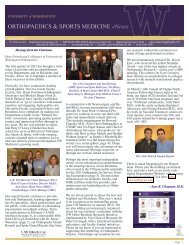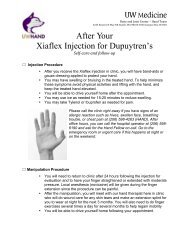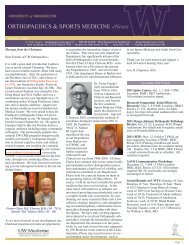2002 - University of Washington Bone and Joint Sources
2002 - University of Washington Bone and Joint Sources
2002 - University of Washington Bone and Joint Sources
You also want an ePaper? Increase the reach of your titles
YUMPU automatically turns print PDFs into web optimized ePapers that Google loves.
The Role <strong>of</strong> Fusion Protein-Induced Alternative Splicing in the<br />
Development <strong>of</strong> Ewing’s Sarcoma<br />
DAVID D. ODELL, B.S., HOWARD A. CHANSKY, M.D., A. ZIELINSKA-KWIATKOWSKA, M.D.,<br />
AND LIU YANG, PH.D.<br />
Cancers arise when genetic<br />
changes, such as chromosomal<br />
translocations <strong>and</strong> point<br />
mutations, enable cells to escape the<br />
control mechanisms that usually serve<br />
to limit cell division to periods <strong>of</strong><br />
growth or normal replenishment <strong>of</strong><br />
cells. A better underst<strong>and</strong>ing <strong>of</strong> the<br />
specific pathways that lead from a<br />
genetic change to a cancerous cell may<br />
yield targets for molecular treatments.<br />
Ewing’s sarcoma is a malignant<br />
neoplasm <strong>of</strong> bone <strong>and</strong> s<strong>of</strong>t tissue. A<br />
chromosomal translocation, t(11;22)<br />
that fuses two distinct genes is<br />
associated with a large percentage<br />
(85%) <strong>of</strong> Ewing’s tumors. The<br />
translocation results in the Ewing’s<br />
sarcoma protein (EWS) being fused to<br />
the DNA binding domain <strong>of</strong> the ETS<br />
transcription factor Fli-1 (Figure 1).<br />
These fusion proteins retain the N-<br />
terminal portion <strong>of</strong> normal EWS (WT-<br />
EWS) while the fusion partner Fli-1<br />
replaces the C-terminal portion <strong>of</strong> WT-<br />
EWS. The N-terminal portion <strong>of</strong><br />
normal EWS has been found to bind<br />
the largest subunit <strong>of</strong> the RNA<br />
polymerase II (Pol II) complex, an<br />
enzyme necessary for transcription <strong>of</strong><br />
genes from DNA to messenger RNA<br />
(mRNA). The C-terminal domain <strong>of</strong><br />
normal EWS recruits proteins referred<br />
to as serine-arginine (SR) splicing<br />
factors that function in splicing the <strong>of</strong><br />
pre-mRNA to mRNA. The EWS/Fli-1<br />
fusion protein retains the ability to bind<br />
RNA Pol II. However, EWS/Fli-1<br />
cannot recruit SR proteins due to the<br />
replacement <strong>of</strong> its C-terminal domain<br />
by the Fli-1fusion partner.<br />
The EWS/Fli-1 fusion protein was<br />
originally believed to induce cellular<br />
transformation through improper<br />
activation <strong>of</strong> Fli-1 target genes.<br />
However, new evidence indicates that<br />
the EWS/Fli-1 fusion protein may<br />
interfere with adapter functions <strong>of</strong><br />
normal-EWS. In an adenovirus E1A<br />
splicing model, EWS/Fli-1 has been<br />
shown to alter splicing <strong>of</strong> exogenous<br />
pre-mRNA when compared to ‘normal’<br />
splicing patterns mediated by WT-<br />
EWS. This study was designed to test<br />
the effects <strong>of</strong> inhibiting expression <strong>of</strong><br />
EWS/Fli-1 on patterns <strong>of</strong> splicing <strong>of</strong><br />
molecules implicated in the<br />
development <strong>of</strong> sarcomas.<br />
RESULTS<br />
Using the Ewing’s sarcoma cell line<br />
SK-N-MC as a model system, a series<br />
<strong>of</strong> transfections were performed to<br />
integrate a “doxycycline-<strong>of</strong>f” antisense<br />
EWS/Fli-1 construct into the genome<br />
<strong>of</strong> the Ewing’s cells. In this system, sense<br />
EWS/Fli-1 is expressed in the presence<br />
<strong>of</strong> doxycycline but upon withdrawal <strong>of</strong><br />
doxycycline the antisense EWS/Fli-1<br />
construct is expressed. Antisense EWS/<br />
FLI-1 then inhibits expression <strong>of</strong> the<br />
‘normal’ EWS/FLI-1 sarcoma protein.<br />
In our genetically engineered Ewing’s<br />
sarcoma cells, induction <strong>of</strong> antisense<br />
EWS/Fli-1 was monitored through the<br />
co-expression <strong>of</strong> green fluorescent<br />
protein (GFP) that could be visualized<br />
using laser light (Figure 2). RT-PCR<br />
analysis <strong>of</strong> EWS/FLI-1 mRNA <strong>and</strong><br />
Western blotting <strong>of</strong> the EWS/Fli-1<br />
fusion protein were used to monitor<br />
EWS/Fli-1 expression in induced <strong>and</strong><br />
non-induced Ewing’s sarcoma cells.<br />
The inducible expression <strong>of</strong> EWS/<br />
Fli-1 antisense RNA proved to be<br />
effective in reducing the quantity <strong>of</strong><br />
EWS/Fli-1 fusion protein to a negligible<br />
level after withdrawal <strong>of</strong> doxycycline<br />
from the culture medium. Comparison<br />
<strong>of</strong> cellular growth rates indicated that<br />
antisense expression correlated with a<br />
decrease in the proliferation <strong>of</strong> Ewing’s<br />
sarcoma cells (Figure 3). In addition,<br />
RT-PCR analysis showed that downregulation<br />
<strong>of</strong> EWS/Fli-1 leads to<br />
changes in mRNA splicing patterns for<br />
the cell surface marker CD44 <strong>and</strong> the<br />
tumor suppressor Bin-1.<br />
DISCUSSION<br />
The EWS/Fli-1 fusion protein is the<br />
hallmark <strong>of</strong> Ewing’s tumors, yet little is<br />
Figure 1: The normal structures <strong>of</strong> the EWS <strong>and</strong> Fli-1 genes are shown with the point <strong>of</strong> fusion indicated on the wild-type EWS gene. The N-terminal RNA Pol<br />
II binding domain remains in the fusion protein while the C-terminal splicing factor-recruiting domain is replaced by the Fli-1 DNA binding domain.<br />
30 <strong>2002</strong> ORTHOPAEDIC RESEARCH REPORT















